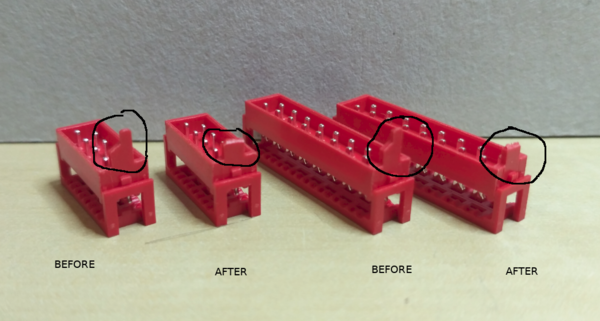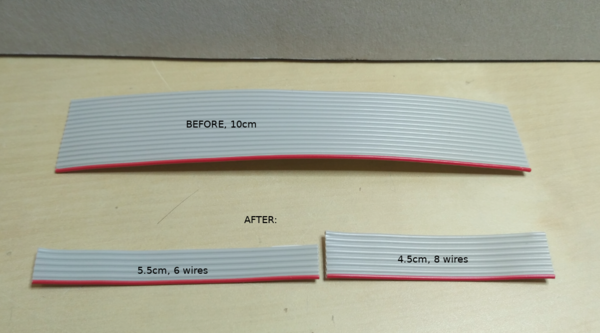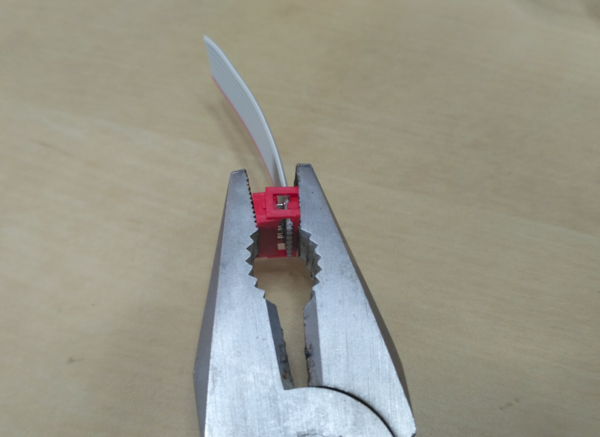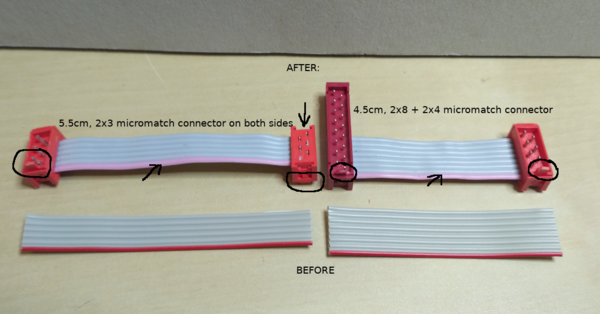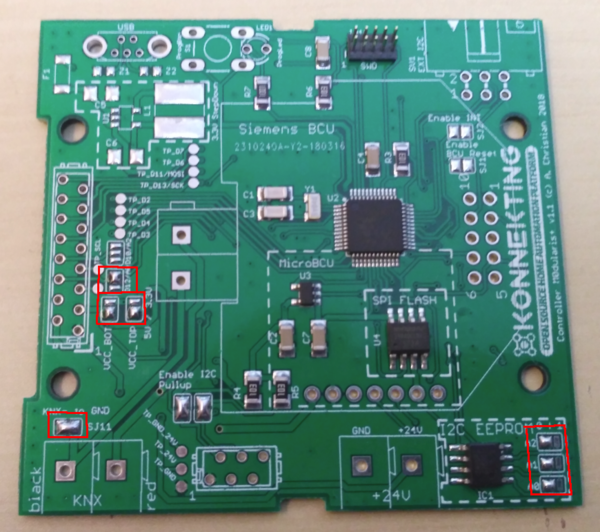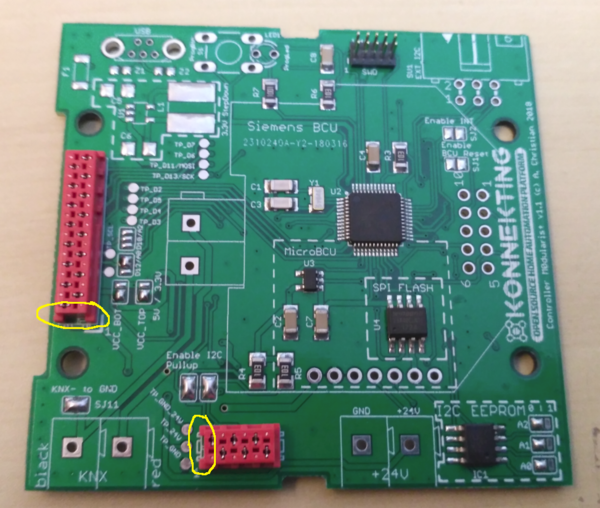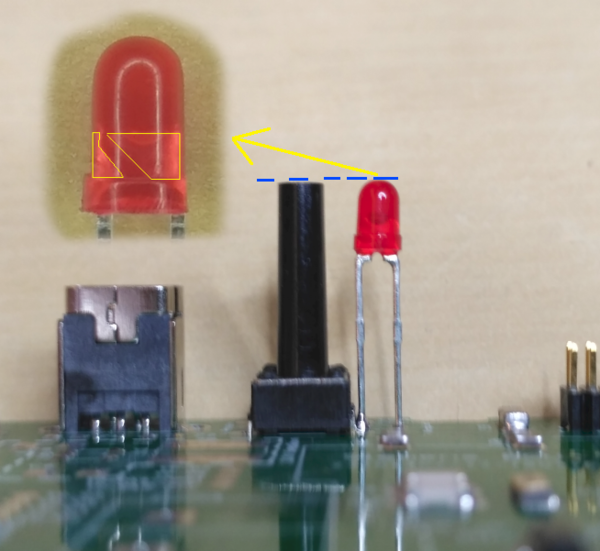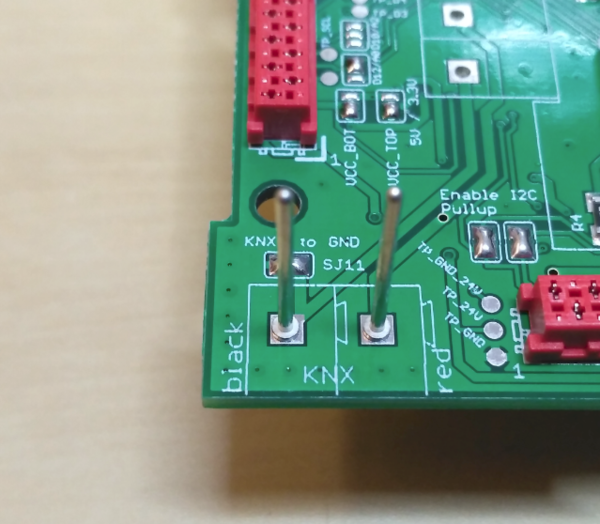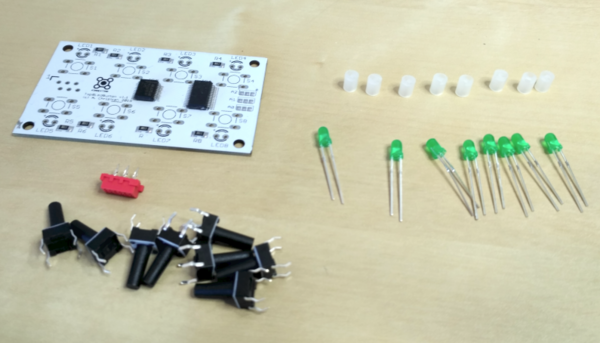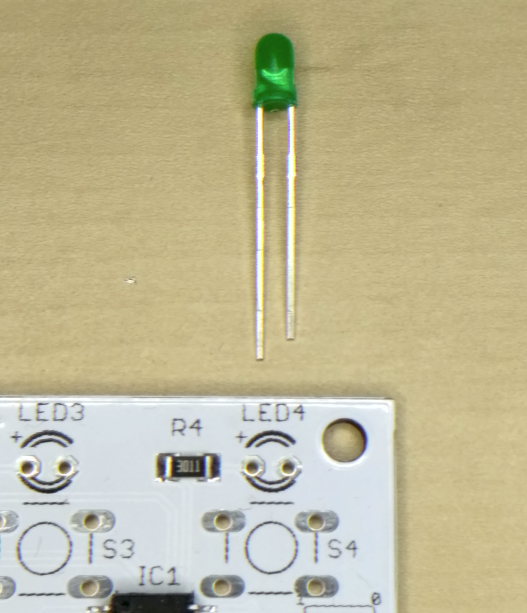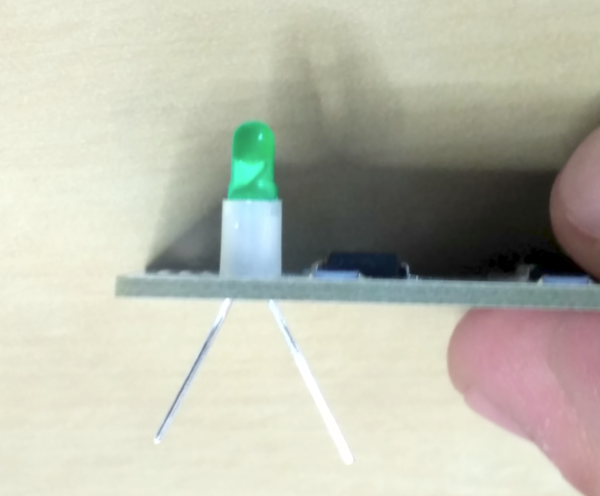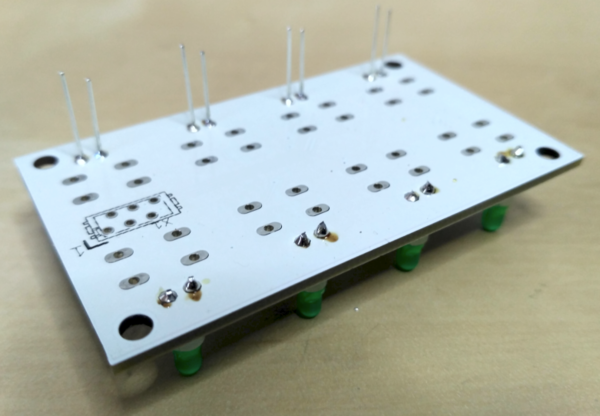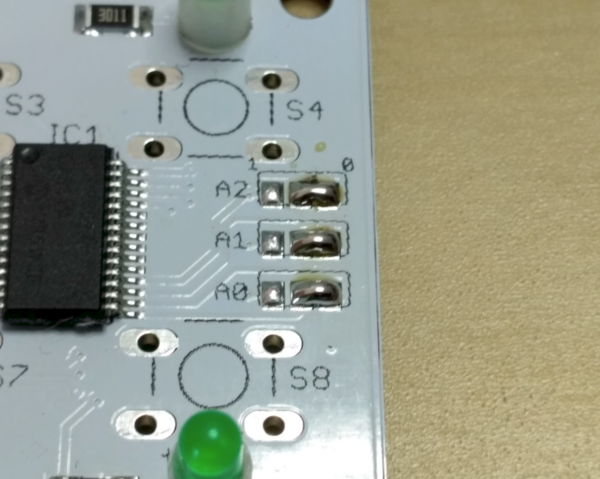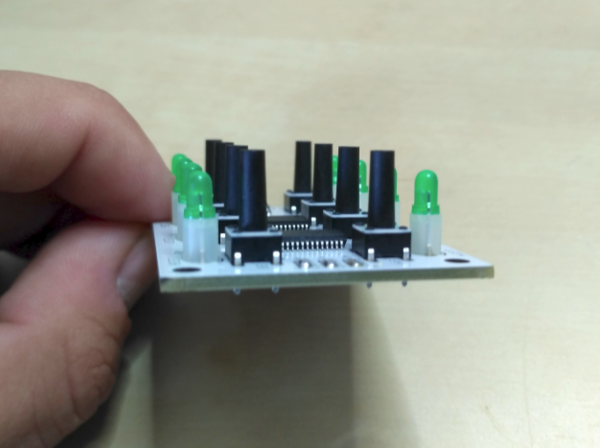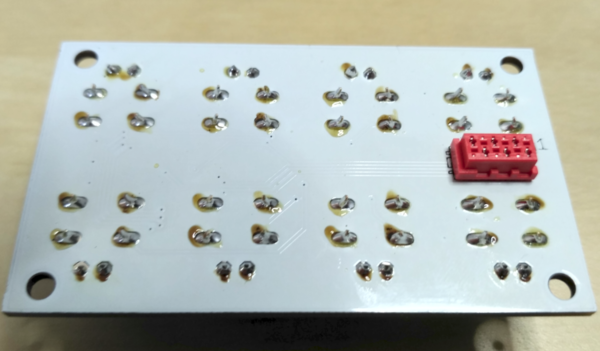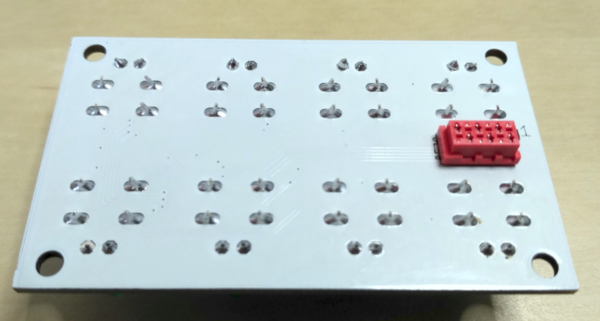Difference between revisions of "DFF4.1 Building Instructions"
Konnekting (talk | contribs) |
Konnekting (talk | contribs) |
||
| Line 94: | Line 94: | ||
Take the 2x4 and 2x8 and both 2x3 micromatch connector (which are not shown, but need to be modified as well) and cut a bit of the orientation pin as shown: | Take the 2x4 and 2x8 and both 2x3 micromatch connector (which are not shown, but need to be modified as well) and cut a bit of the orientation pin as shown: | ||
| − | [[File:DFF4. | + | [[File:DFF4.1 Building Instruction cutmicromatchorientationpin.png|600px]] |
This is required, as the PCB is unfortunately missing the matching hole for this orientation pin. | This is required, as the PCB is unfortunately missing the matching hole for this orientation pin. | ||
| Line 110: | Line 110: | ||
The result shoud look like this: | The result shoud look like this: | ||
| − | [[File:DFF4. | + | [[File:DFF4.1 Building Instruction cutribboncable.png|600px]] |
Carefully put the micromatch connector (2x3 for 6-wire and 2x4 + 2x8 for the 8-wire) onto the ribbon cable and crimp the connector with help of a pliers. | Carefully put the micromatch connector (2x3 for 6-wire and 2x4 + 2x8 for the 8-wire) onto the ribbon cable and crimp the connector with help of a pliers. | ||
| − | [[File:DFF4. | + | [[File:DFF4.1 Building Instruction micromatchcrimp.png|600px]] |
Be really careful and take your time. Ensure that you crimp both micromatch parts as parallel as possible. And don't put too much pressure on the plastic. Otherwise you risk damage of micromatch plug! | Be really careful and take your time. Ensure that you crimp both micromatch parts as parallel as possible. And don't put too much pressure on the plastic. Otherwise you risk damage of micromatch plug! | ||
Ensure that you put the red-wire to the side of the orientation-pin of micromatch connector and that you put one of the 2x3 connectors with face down as shown. | Ensure that you put the red-wire to the side of the orientation-pin of micromatch connector and that you put one of the 2x3 connectors with face down as shown. | ||
| − | [[File:DFF4. | + | [[File:DFF4.1 Building Instruction assembledmicromatch.png|600px]] |
'''When soldering the sockets, LEDs or switches, ...: Start with soldering just one pin. Then check the alignment. If realignment is needed, re-heat the the pin and realign. If alignment is okay, solder the remaining pins. Fixing a wrong alignment afterwards is tricky and you might ruin the PCB. So do it first time right and check alignment twice.''' | '''When soldering the sockets, LEDs or switches, ...: Start with soldering just one pin. Then check the alignment. If realignment is needed, re-heat the the pin and realign. If alignment is okay, solder the remaining pins. Fixing a wrong alignment afterwards is tricky and you might ruin the PCB. So do it first time right and check alignment twice.''' | ||
| Line 153: | Line 153: | ||
A2: 0 | A2: 0 | ||
| − | [[File:DFF4. | + | [[File:DFF4.1 Building Instruction sjcontroller.png|600px]] |
Put in micromatch sockets and solder them. Check the right orientation according to the picture here: | Put in micromatch sockets and solder them. Check the right orientation according to the picture here: | ||
| − | [[File:DFF4. | + | [[File:DFF4.1 Building Instruction micromatchsocket.png|600px]] |
Put in MiniUSB socket and solder the pins. Ensure that the two outer shielding pins have good contact and enough solder. | Put in MiniUSB socket and solder the pins. Ensure that the two outer shielding pins have good contact and enough solder. | ||
| Line 165: | Line 165: | ||
'''Check the polarity twice! Unsoldering the LED might kill the trough-hole-contact and your PCB is trash!''' | '''Check the polarity twice! Unsoldering the LED might kill the trough-hole-contact and your PCB is trash!''' | ||
| − | [[File:DFF4. | + | [[File:DFF4.1 Building Instruction LedAndButton.png|600px]] |
Put in the KNX pins and solder them. | Put in the KNX pins and solder them. | ||
| − | [[File:DFF4. | + | [[File:DFF4.1 Building Instruction knxpins.png|600px]] |
= Frontend = | = Frontend = | ||
| Line 175: | Line 175: | ||
Search the parts you need for the frontend: | Search the parts you need for the frontend: | ||
| − | [[File:DFF4. | + | [[File:DFF4.1 Building Instruction frontendparts.png|600px]] |
Check the LED polarity. you will have to put in the LED as shown: The long leg with the "tiny part" in the LED is "+", the short leg with the "big part" in the LED is "-" (the other whole on the PCB): | Check the LED polarity. you will have to put in the LED as shown: The long leg with the "tiny part" in the LED is "+", the short leg with the "big part" in the LED is "-" (the other whole on the PCB): | ||
| − | [[File:DFF4. | + | [[File:DFF4.1 Building Instruction frontendledorientation.png|600px]] |
Use the spacer to get the right distance between PCB and LED. You may need to push in the LED quite hard to get a flat sitting LED and spacer. it should finally look like this: | Use the spacer to get the right distance between PCB and LED. You may need to push in the LED quite hard to get a flat sitting LED and spacer. it should finally look like this: | ||
| − | [[File:DFF4. | + | [[File:DFF4.1 Building Instruction frontendledalignment.png|600px]] |
After soldering, cut the LED legs as shown (cut all of them of course ;-) ): | After soldering, cut the LED legs as shown (cut all of them of course ;-) ): | ||
| − | [[File:DFF4. | + | [[File:DFF4.1 Building Instruction frontendcutledpins.png|600px]] |
Next you put in the micromatch on the bottom of the PCB like this. If you got a micromatch socket which has the shown gap only on one side, ensure you out it in like shown: | Next you put in the micromatch on the bottom of the PCB like this. If you got a micromatch socket which has the shown gap only on one side, ensure you out it in like shown: | ||
| − | [[File:DFF4. | + | [[File:DFF4.1 Building Instruction frontendmicromatch.png|600px] |
Set the I2C address as shown by putting some solder on the pads. Ensure that solder-jumpers for I2C adress is correctly set to: | Set the I2C address as shown by putting some solder on the pads. Ensure that solder-jumpers for I2C adress is correctly set to: | ||
| Line 199: | Line 199: | ||
A2: 0 | A2: 0 | ||
| − | [[File:DFF4. | + | [[File:DFF4.1 Building Instruction frontendi2caddress.png|600px]] |
Finally put in the buttons and solder them. Ensure that they are sitting totally flat on the PCB: | Finally put in the buttons and solder them. Ensure that they are sitting totally flat on the PCB: | ||
| − | [[File:DFF4. | + | [[File:DFF4.1 Building Instruction frontendbuttonsalignment.png|600px]] |
If, after soldering, you have a lot of ugly flux on the PCB like this: | If, after soldering, you have a lot of ugly flux on the PCB like this: | ||
| − | [[File:DFF4. | + | [[File:DFF4.1 Building Instruction frontendflux.png|600px]] |
... use some flux cleaner (f.i. plenty of Isopropanol. You get this on [https://www.amazon.de/Isopropanol-Isopropylalkohol-Klar-99-1000/dp/B00JXK92YI/ref=sr_1_4?ie=UTF8&qid=1525194236&sr=8-4&keywords=isopropanol Amazon]) and an old toothbrush to clean it. Finally it will look like this: | ... use some flux cleaner (f.i. plenty of Isopropanol. You get this on [https://www.amazon.de/Isopropanol-Isopropylalkohol-Klar-99-1000/dp/B00JXK92YI/ref=sr_1_4?ie=UTF8&qid=1525194236&sr=8-4&keywords=isopropanol Amazon]) and an old toothbrush to clean it. Finally it will look like this: | ||
| − | [[File:DFF4. | + | [[File:DFF4.1 Building Instruction frontendfluxremoved.png|600px]] |
= Application = | = Application = | ||
Revision as of 07:20, 6 May 2018
Preparation
Check that all parts are there:
| Pcs. | Part |
|---|---|
| 2 | M3 hex-spacer, nylon, 15mm, with M3 screw on one end and inner thread on other end. |
| 2 | M3 hex-spacer, nylon, 18mm, with inner threads on both ends |
| 4 | M3 screw, nylon |
| 8 | relay |
| 8 | screw terminals, cage |
| 8 | 3mm LED, green |
| 8 | 3mm LED spacer, 5mm height |
| 1 | 3mm LED, red |
| 8 | tactile push button, xx mm, "Frontend Buttons" |
| 1 | tactile push button, xx mm, "Programming Button" |
| 1 | DIN Rail enclosure, consisting of:
|
| 1 | MiniUSB socket, vertical |
| 2 | micromatch socket, 2x3 pin |
| 1 | micromatch socket, 2x8 pin |
| 1 | micromatch socket, 2x4 pin |
| 2 | micromatch plug, 2x3 pin |
| 1 | micromatch plug, 2x8 pin |
| 1 | micromatch plug, 2x4 pin |
| 1 | pcs of flat cable |
| 1 | PCB enclosure cover, printed and drilled |
| 1 | M0dularis+ controller PCB |
| 1 | Frontend PCB, 8 Buttons, 8 LEDs |
| 1 | Application PCB, 8x BiRelay |
| 1 | MicroBCU with pinheaders |
| 2 | pins for KNX connection |
Take the 2x4 and 2x8 and both 2x3 micromatch connector (which are not shown, but need to be modified as well) and cut a bit of the orientation pin as shown:
This is required, as the PCB is unfortunately missing the matching hole for this orientation pin.
Take the 10cm ribboncable and cut the following lengths:
- 5.5cm
- 4.5cm
then
- take the 5.5cm part and reduce the wirecount to 6 wires, incl. one red wire
- take the 4.5cm part and reduce the wirecount to 8 wires, incl. one red wire
The result shoud look like this:
Carefully put the micromatch connector (2x3 for 6-wire and 2x4 + 2x8 for the 8-wire) onto the ribbon cable and crimp the connector with help of a pliers.
Be really careful and take your time. Ensure that you crimp both micromatch parts as parallel as possible. And don't put too much pressure on the plastic. Otherwise you risk damage of micromatch plug! Ensure that you put the red-wire to the side of the orientation-pin of micromatch connector and that you put one of the 2x3 connectors with face down as shown.
When soldering the sockets, LEDs or switches, ...: Start with soldering just one pin. Then check the alignment. If realignment is needed, re-heat the the pin and realign. If alignment is okay, solder the remaining pins. Fixing a wrong alignment afterwards is tricky and you might ruin the PCB. So do it first time right and check alignment twice.
When soldering LEDs check the polarity twice. Unsoldering "through-hole" pins can ruin the through-hole-contact and thus the whole PCB. So be careful.
It's recommended that you stick to the here described order of adding parts to the PCB. That will ease the whole process for you
Controller
Close solder jumpers as shown here. Some of them might have been already closed for first production test. If so, ensure the jumpers are closed as shown.
VCC TOP:
5V
VCC BOT:
5V
D12/A0:
A0
D10/A2:
leave unset
I2C EEPROM:
A0: 0 A1: 0 A2: 0
Put in micromatch sockets and solder them. Check the right orientation according to the picture here:
Put in MiniUSB socket and solder the pins. Ensure that the two outer shielding pins have good contact and enough solder.
Put in the programming button and the LED as shown and solder them as well. Tip: It's easier to adjust the height of the LED when just soldering one pin an adjust heigth while re-heating the pin. Then check alignment and solder second pin.
Check the polarity twice! Unsoldering the LED might kill the trough-hole-contact and your PCB is trash!
Put in the KNX pins and solder them.
Frontend
Search the parts you need for the frontend:
Check the LED polarity. you will have to put in the LED as shown: The long leg with the "tiny part" in the LED is "+", the short leg with the "big part" in the LED is "-" (the other whole on the PCB):
Use the spacer to get the right distance between PCB and LED. You may need to push in the LED quite hard to get a flat sitting LED and spacer. it should finally look like this:
After soldering, cut the LED legs as shown (cut all of them of course ;-) ):
Next you put in the micromatch on the bottom of the PCB like this. If you got a micromatch socket which has the shown gap only on one side, ensure you out it in like shown:
[[File:DFF4.1 Building Instruction frontendmicromatch.png|600px]
Set the I2C address as shown by putting some solder on the pads. Ensure that solder-jumpers for I2C adress is correctly set to:
A0: 0 A1: 0 A2: 0
Finally put in the buttons and solder them. Ensure that they are sitting totally flat on the PCB:
If, after soldering, you have a lot of ugly flux on the PCB like this:
... use some flux cleaner (f.i. plenty of Isopropanol. You get this on Amazon) and an old toothbrush to clean it. Finally it will look like this:
Application
Ensure that solder-jumpers for I2C adress is correctly set to:
A0: 1 A1: 0 A2: 0
Put in the 2x4 micromatch socket and solder the pins.
INSERT IMAGE HERE
Put in the screw terminals and solder them. Try to align the terminals to the outer PCB line.
INSERT IMAGE HERE
Put in the relays als solder them. If possible, keep at least a minimum space between the relays and also to next terminals.
INSERT IMAGE HERE
